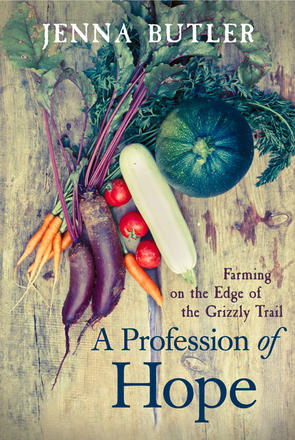Your cart is currently empty!
Fresh from the Farm: Fall Fare for Your Body & Mind from Jenna Butler’s A Profession of Hope
Fall is officially upon us – the season of crisp air, colourful foliage, and one last (hopefully bountiful) harvest before the fields are blanketed with snow. At Thanksgiving, especially, we are reminded of the beauty and bounty around us, and how grateful we should be for it. That makes it the perfect time for poet-farmer Jenna Butler’s Thai Red Curry Squash Soup and thought-provoking collection of ecological essays, A Profession of Hope: Farming on the Edge of the Grizzly Trail (Wolsak & Wynn, 2015).

Fall is officially upon us – the season of crisp air, colourful foliage, and one last (hopefully bountiful) harvest before the fields are blanketed with snow. At Thanksgiving, especially, we are reminded of the beauty and bounty around us, and how grateful we should be for it. That makes it the perfect time for poet-farmer Jenna Butler’s Thai Red Curry Squash Soup and thought-provoking collection of ecological essays, A Profession of Hope: Farming on the Edge of the Grizzly Trail.
In the book, Butler turns her ecological sensibility and poet’s eye to the small farm she and her husband, Thomas, run in Alberta’s North Country. With prose no less powerful for its lyricism, Butler explores the many challenges – both physical and philosophical – of living off and protecting the land. Part memoir, part call to action, these essays blur the lines between literature and rhetoric much as Larch Grove Farm blurs the borders between cultivated and wild spaces.
A Profession of Hope: Farming on the Edge of the Grizzly Trail is now available. Curl up with your copy and a steaming of bowl of this delicious soup. Now that’s a recipe for a perfect winter afternoon!
*******
**ALU Note: We are giant soup nerds and most-definitely made this soup. We can attest to its deliciousness!
Thai Red Curry Squash Soup
Ingredients:
- 1 large winter squash (acorn or butternut works best)
- 2 cups chopped leek shanks (blanched white part of the leek)
- 2 tbsp. butter for frying
- 1 tbsp. Thai red curry paste
- 1 ½ cups chicken stock
- 1 can unsweetened coconut milk
- Pinch of salt
- Cilantro to garnish (optional)
Directions:
1) Halve and roast squash well in baking pan (approx. 1 hour), then cube squash and discard skin.
2) Fry leek shanks in butter; when wilted, add curry paste and mix well.
3) Heat chicken stock in saucepan; add cubed squash and leek mixture.
4) In separate small saucepan, heat coconut milk over medium heat to combine liquids and solids, then add to main pot.
5) Add salt to taste.
6) Cook soup for 30 minutes on medium heat, then mash or blend.
7) Serve hot with cilantro garnish.
Notes from Jenna Butler:
We love Thai squash soup on the farm during the cold months. There’s something inherently comforting about gathering together the stored root vegetables that we harvested from the garden in autumn and cooking them into a hearty soup that sustains us as we go about the seasonal tasks of brush clearing, wood chopping, and snow shovelling.
Growing Winter Squash
Winter squash are really easy to grow, and most gardens have room for a couple of vines (if you don’t have much ground space, take advantage of the vines’ climbing nature and grow them vertically!). The seeds sprout readily within a few days of sowing, but beware: squash don’t transplant well, so be sure to start them in at least 4” pots with plenty of root room. We start ours late under grow lights, often into May, and transplant them out once the danger of frost has passed. The seedlings are tucked into hills of half garden soil, half compost. They dig their roots into this rich mixture and grow like bonkers. Make sure that however you plant them, the squash have access to as much light as possible. They definitely like to bask.
Keep an eye on your squash vines, especially if you’re growing more than one type. Plants from the same family will cross-pollinate, and you can end up with some weird and unexpected hybrids that look odd and taste pretty awful! Be especially careful when growing winter squash and pumpkins in the same patch – they’ll cross readily, and you’ll end up with strange, gourd-like creatures that are no good for carving or for pie. It helps to use a floating row cover to isolate the plants, but your best bet is to separate the different types of squash as much as you can.
Harvesting and Storing Winter Squash
Harvest your squash before a hard frost threatens – the fruit can stand a bit of cold, but the vines will wither at the first breath of chill. We lay our winter squash out in the unheated cookhouse to season for about a week after harvest; the squash skins need to toughen so that they’ll store for the long months of winter. They’re ready to store when the skins are too hard to dent with a fingernail.
Winter squash are easy keepers. They like things dry and cool; under the bed often proves the ideal storage space. Properly seasoned, they should keep for several months. There’s little that’s more reassuring than a bumper crop of winter squash squirrelled away, promising warm meals all winter long.
* * *
Thanks so much to Emily from Wolsak & Wynn for helping us get this post together, and to Jenna for adding a forever-soup to our recipe roster.
Tagged:




